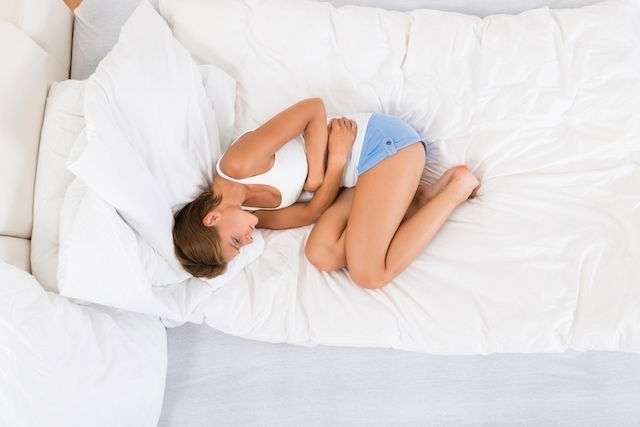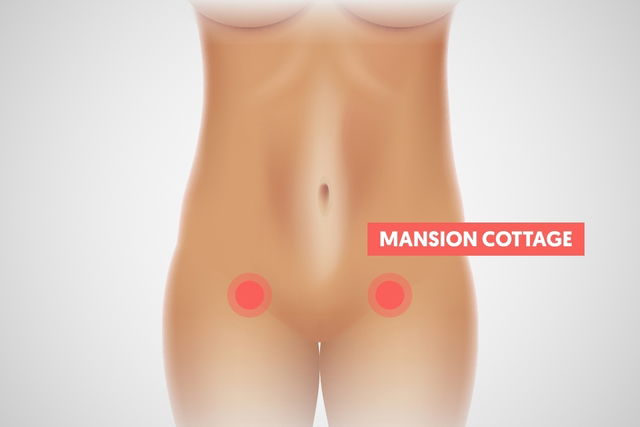Period cramps can be very uncomfortable and can make you feel sick. There are some ways you can relieve pain at home, like applying a hot water bottle on the abdomen, drinking ginger tea with valerian or eliminating caffeine from your diet.
Menstrual cramps, also known as dysmenorrhea, are typically felt in the lower abdomen. Many women can start to feel them at the end of their menstrual cycle, days before their period starts. Discomfort and cramping can persist until the period ends.
Cramps that are very painful, frequent and disrupting your daily routine should be assessed by a doctor to ensure there are no other underlying issues contributing to the cramping. Some conditions, like endometriosis, require further treatment with medication.

Tips for period cramp relief
Check-out ways you can manage your period cramps naturally:
1. Warm water compresses
A very tried-and-true method that is very effective in relieving period cramps is applying heat to the abdomen. This helps to relax the muscles contracting in the abdomen to relieve cramping.
Take a hot water bottle or a warm towel and place on the abdomen for 10 to 15 minutes when you are feeling the cramping. If the hot water bottle or towel is too hot to apply directly to the skin, wait for it to cool, wrap it in a cloth, or apply over the clothing.
2. Ginger tea with valerian
There are many teas with properties that can help relieve period cramps. Two herbs that are especially effective are ginger and valerian, which can infused together for a more potent effect.
To make this tea, place 2 cm of ginger root and 1 teaspoon of valerian root into 250mL of boiling water. Allow to soak for 10 to 15 minutes, then strain, allow to cool and drink 2 to 3 times per day.
This tea combined the anti-inflammatory effect of ginger with the relaxing effect of valerian, which makes it a great way to combat all discomfort associated with menstruation. Valerian is also a great herb for treating anxiety, which can become heightened during a period.
3. Using acupressure

Reflexology is a natural therapy that uses pressure points throughout the body to treat pain and relieve other symptoms. It has very minimal contraindications and can be used by any woman at home.
The "Mansion Cottage" pressure point can be used to relieve pain from period cramps. It is located along the line right above the pelvis, where abdomen connects to the legs (as shown above).
To use this pressure point, apply mild pressure to the area using your palm or a finger. Then maintain the pressure and massage in circular motions for 5 to 10 minutes.
4. Exercise and stretches
Some stretches that help to reduce pain from period cramps are:
- Exercise 1: Lie on your back and hug your knees to your chest
- Exercise 2: Lie on your back, tuck your heels into your glutes, and drop your knees to your sides (also known as a lying butterfly stretch)
Regular physical activity can also release endorphins, which act as a natural analgesic that boost mood. Engaging in daily walks, swimming, yoga or cycling can help to prevent or reduce period cramps.
5. Abdominal massage
Massaging your abdomen can help relax your pelvic muscles and relieve menstrual cramps quickly.
To enhance the effect of the massage, you can use essential oils, such as lavender essential oil, mixed with a carrier oil, such as coconut oil, sweet almond oil or even olive oil. Mix these together and apply to the skin, massaging the belly in circular movements.
6. Maintaining hydration
Drinking more water helps to reduce bloating that can cause more pain and discomfort from menstrual cramps.
Additionally, drinking more water helps to improve general and specifically promoting blood flow the the uterus. This can reduce the duration of your period and cramp intensity.
7. Anti-inflammatory foods
Eating anti-inflammatory foods, such as turmeric or spinach, as well as foods rich in omega-3 such as tuna, sardines, salmon, flaxseed or chia, help can reduce the production of inflammatory substances and relieve menstrual cramps more quickly.
These foods should generally be consumed daily, while fish should be consumed at least 3 to 5 times a week. Learn more about the anti-inflammatory diet and which foods you should eat.
8. Avoiding caffeine and alcohol
Caffeine (from coffee, tea, energy drinks and chocolate) and alcohol are substances that can worsen the intensity of cramping in most women. Therefore, you should eliminate these substances, or at least decrease intake, when experiencing period cramps.
9. Avoiding sweets and salty snacks
Sweets and salty snacks can cause bloating and fluid retention, which can make cramping worse. Therefore, you are advised to maintain a balanced diet with fruits, greens, chicken and fish. Meals should be small and spaced throughout the day.
10. High-magnesium foods
Some studies [1,2] have shown that magnesium can help reduce the production of prostaglandins that cause contractions in the uterus. This can reduce the intensity and duration of period cramps.
Therefore, it is recommended to consume foods rich in magnesium, such as seeds, peanuts, oats, bananas or milk, for example. See the complete list of foods rich in magnesium.
Furthermore, another option is to use magnesium supplements prescribed by your gynecologist to prevent menstrual cramps.
What to do if cramping doesn’t improve
If the cramps do not improve with these home remedies, you should see a doctor for further assessment and treatment. The doctor may opt to prescribe medications like analgesics, anti-inflammatories and antispasmodics to manage pain and uterine contractions.
Some commonly prescribed medications include ibuprofen, ketoprofen, scopolamine and acetaminophen. Dosing and frequency will depend on the intensity of pain and whether other symptoms are present.
